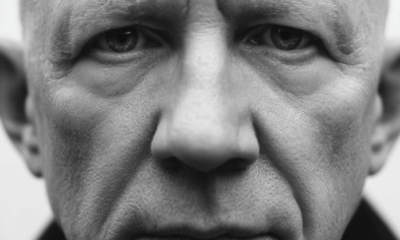Success Advice
Tell a Story, Don’t List Benefits – How the Science of Storytelling Will Transform Your Business

If you’d like to learn how to tell amazing stories so you can influence people to act, sign up for the free 90-Day Master Class hosted by the founder of Addicted2Success.com, Joel Brown.
In 2009, a man bought 200 objects on Ebay for $129 and sold them for $8000. How did he achieve an increase of 6202 percent? He did it by adding a story. He commissioned 200 writers to tell a story about each object. This experiment proved: the power of storytelling is real.
How can anyone justify wearing a pair of sneakers that costs at least four times the manufacturing price? The purchase is not rationalized by some extra rubber or innovative material, nor by a special fit or an extraordinary energy boost. We all know the truth: a sneaker is a sneaker. But by wearing a 100 Dollar sneaker you become part of a story.
At an auction, someone bought a Nike sneaker for $475,500, and it was not because of some rational benefits. It was because the buyer became part of a mythical sneaker history, where the shoes were made by Nike co-founder Bill Bowerman, who used his wife’s waffle iron to create a new kind of running shoe. It’s like owning the Mona Lisa.
Why doesn’t GoPro advertise the cool technical features of its camera on the front page? They could have said, GoPro has an unshakable HyperSmooth 2.0 stabilization and built-in mounting. Instead, they say, GoPro helps people capture and share their lives’ most meaningful experiences with others—to celebrate them together. Of course, they list the benefits. But first, they tell a story.
Many start-ups and entrepreneurs make a fatal mistake. They start with listing the benefits. The result? In a world where everybody is competing for attention—a limited resource to give—their business drowns in the noise. If you want people’s attention, you need to start with a story. Not just any story, but a compelling narrative with three ingredients.
The neurochemical “angel’s cocktail” you need for a good story
Paul Zak did an experiment where he showed people two types of short videos:
- a sad story about a father and son that had an intriguing start, a climax and a compelling ending
- a person walking about aimlessly during the video
The brains of the ones who watched the first video produced two neurochemicals: Cortisol and Oxytocin. Those people also took desired action—they made donations. The second video didn’t engage the audience’s brains in any way.
In a related experiment, people infused with oxytocin turned out to be 80% more generous than others when splitting money. David JP Phillips adds another hormone and calls it the “angel’s cocktail”—the mixture of the three chemicals you need for a compelling story.
“Good stories surprise us. They make us think and feel. They stick in our minds and help us remember ideas and concepts in a way that a PowerPoint crammed with bar graphs never can.” – Joe Lazauskas & Shane Snow
Dopamine—the attention hormone
“We discovered that, in order to motivate a desire to help others, a story must first sustain attention—a scarce resource in the brain—by developing tension during the narrative.” – Paul Zak
The release of dopamine motivates us, helps us focus and sustains memory. If you want to stand out from the noise that has become abundant in this world—and will increase in the future—you need this hormone.
In storytelling, dopamine is produced by creating tension and using a cliffhanger. Here’s an example: “You better not tell nobody but God” is the first sentence in Alice Walker’s masterpiece “The Color Purple”. It raises tension and questions you need answered. This way, it triggers the release of dopamine in the brain. We’re instantly paying attention.
Oxytocin—the bonding hormone
Empathy is the key to a story that inspires action. In a brand story, the hero is always the customer. Never make your brand or product the hero. This is a fatal mistake that has cost many businesses and products their existence.
To make the customer the hero, you need to understand him. What is his or her desire? What keeps him awake at night? What are her greatest problems and fears? If you know the answers, you can create a story that evokes empathy—that shows that you understand the customer and releases Oxytocin to build trust and form a bond.
“I’m obsessed with giving the audience something they don’t see coming.” – Jordan Peele
Endorphin—the happiness hormone
There is one ingredient added to the angel’s cocktail. One that explains why we love the Late Night Show, sitcoms and plain entertainment. Research firm PwC anticipates revenue from media and entertainment will reach an estimated $2.2 trillion by 2021.
Why do we spend so much money on being entertained and not informed? Because of endorphins that are released in our brain when humor comes into play. When your story makes the audience laugh, they feel more relaxed and creative. You need this desperately to combat the stress and anxiety of everyday life.
Start with an image
Stories are the pathway to engaging our right brain and triggering imagination. Start your story by creating a powerful image that both grabs the customer’s attention and will be remembered for a long time.
Find an image that triggers the angel’s cocktail by adding tension, empathy and entertainment. Let’s go back to Nike’s campaign: Equality isn’t a game. But achieving it will be our greatest victory.
It raises tension by asking: How can we achieve equality? And will we? It triggers empathy by creating a common cause that matters to the customers: equality. And it provides entertainment by the comparison between sports (‘game’) and a political cause.
Never underestimate the power of storytelling. A compelling story can increase the value of a product by over 6000 percent. If you want to stand out from the noise, use the science of storytelling.
But remember, the story has to be authentic. Storytelling in marketing is not about manipulation because sooner or later, your audience will discover a fake, and it will ruin your company. The power of storytelling means using a privilege and telling a brand story that provides your customers with a value they wouldn’t have found without it.
What do you think about storytelling? Is it something you’re good at & have seen the benefits? Share your stories with us below!
Did You Know
How Skilled Migrants Are Building Successful Careers After Moving Countries
Behind every successful skilled migrant career is a mix of resilience, strategy, and navigating systems built for locals.

Moving to a new country for work is exciting, but it can also be unnerving. Skilled migrants leave behind familiar systems, networks, and support to pursue better job opportunities and a better future for their families. (more…)
Life
10 Research-Backed Steps to Create Real Change This New Year
This New Year could finally be the one where you break old patterns and create real, lasting change.

Every New Year, we make plans and set goals, but often repeat old patterns. (more…)
Change Your Mindset
The Silent Skill That Makes People Respect You Instantly
What truly earns respect and why most people go about it the wrong way

Everybody craves respect but not everyone earns it. Some people believe that a title, years of experience, or a position of authority automatically entitles them to respect. (more…)
Entrepreneurs
The Essential Skills Every Entrepreneur Needs In 2026
Success in the digital age isn’t about luck. It’s about mastering the skills that separate dreamers from doers.

When I was 22 years old, I started my first side hustle as a ghostwriter. (more…)
-

 Shift Your Mindset4 weeks ago
Shift Your Mindset4 weeks ago11 E’s That Define Every Great Leader And Why Most People Miss Them
-

 Did You Know4 weeks ago
Did You Know4 weeks agoThe Success Patterns You Inherited (And Didn’t Notice)
-

 Entrepreneurs3 weeks ago
Entrepreneurs3 weeks agoThe Essential Skills Every Entrepreneur Needs In 2026
-

 Business4 weeks ago
Business4 weeks agoThe Hidden Money Pit in Your Operations (and How to Use It)
-

 Change Your Mindset2 weeks ago
Change Your Mindset2 weeks agoHow to Turn Your Mind Into Your Greatest Asset (Instead of Your Enemy)
-

 Change Your Mindset2 weeks ago
Change Your Mindset2 weeks agoThe Silent Skill That Makes People Respect You Instantly
-

 Life2 weeks ago
Life2 weeks ago10 Research-Backed Steps to Create Real Change This New Year
-

 Tech1 week ago
Tech1 week agoWhat’s in a Name? How to Get Your Domain Right

























